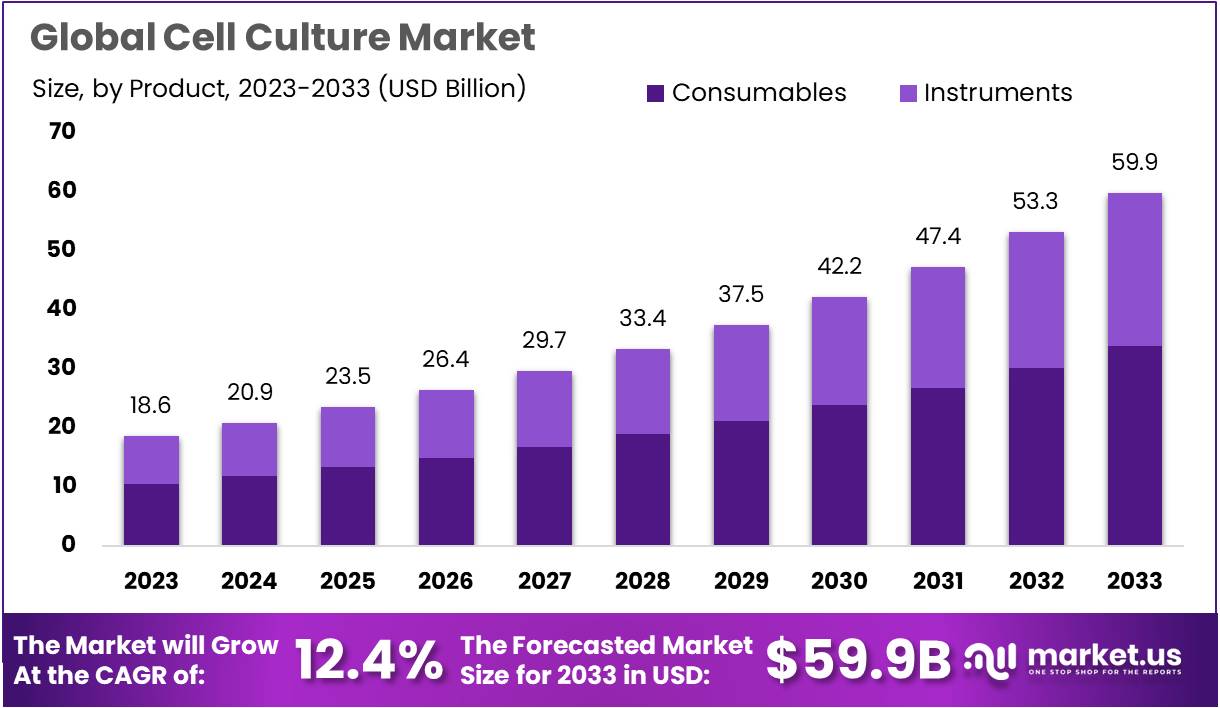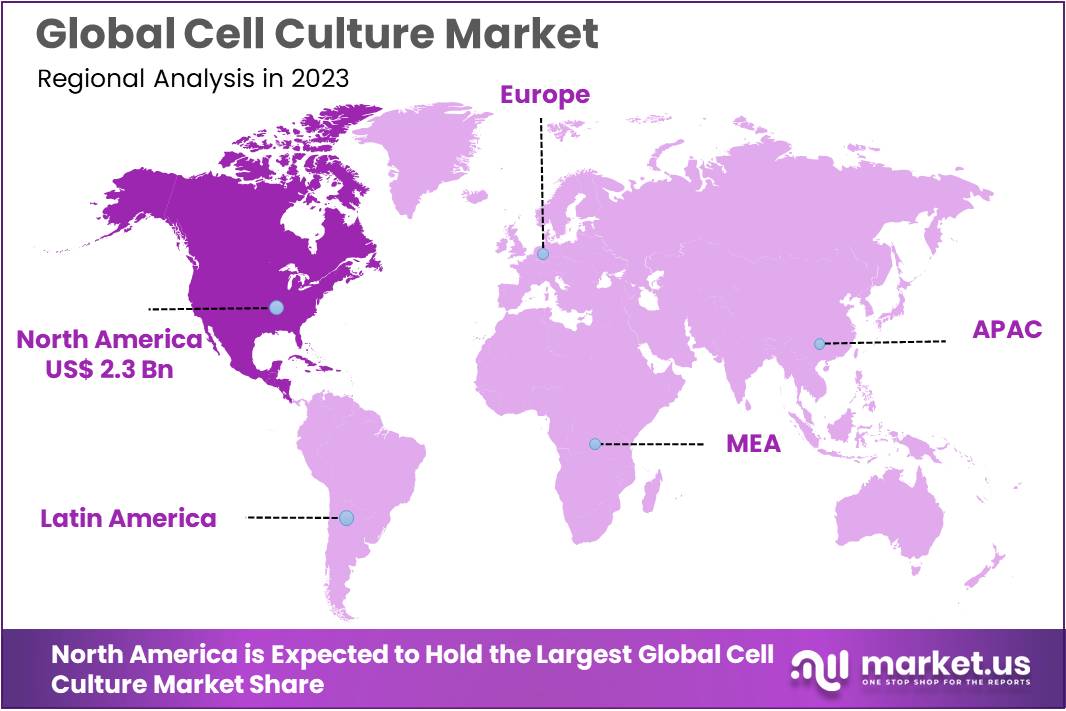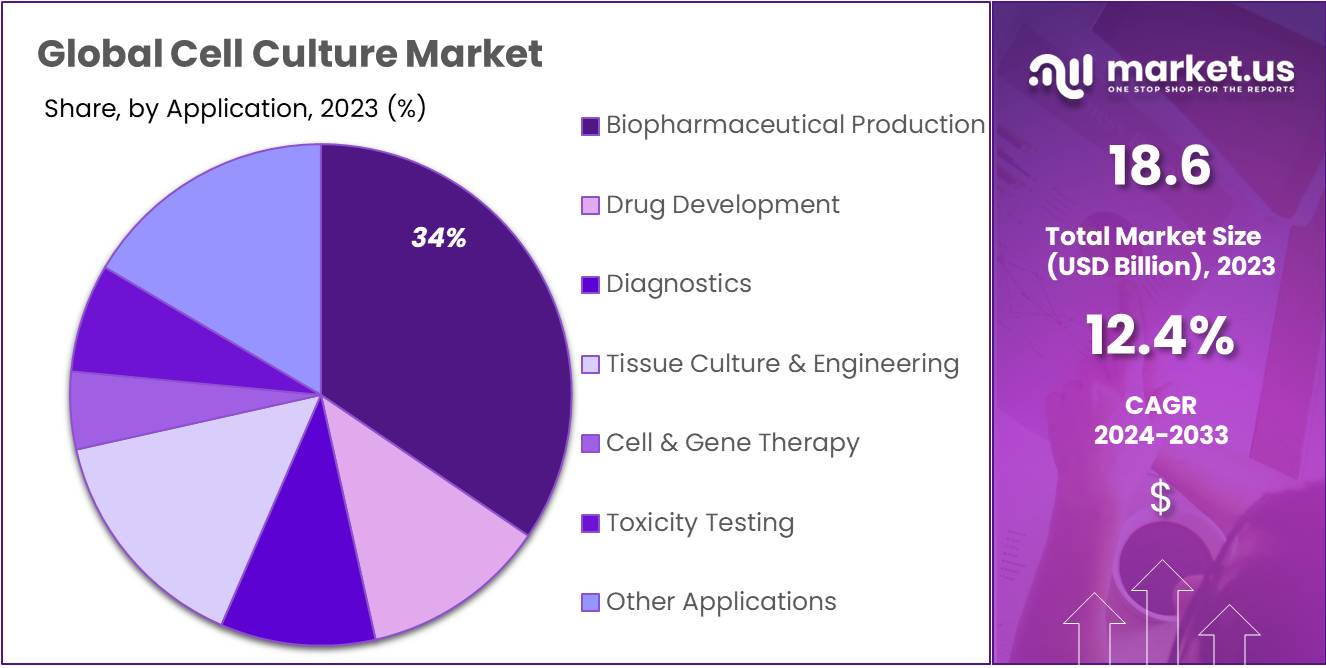New York, Jan. 29, 2024 (GLOBE NEWSWIRE) -- According to Market.us, the cell culture market size is forecasted to surpass around USD 59.9 Billion by 2033, and expected to reach a CAGR of 12.4% from 2024 to 2033.
A vital laboratory technique used to cultivate and maintain cells invitro for research and biotechnological purposes is popularly known as cell culture technique. The method involves culturing of diverse cell lines such as primary and immortalized cell lines in a controlled environment, nurtured by specific growth medium. Maintanence of optimal conditions such as temperature, pH, and CO2, concentration is the most crucial task. This technique plays a vital role in scientific research, drug development and disease modelling.
Download Exclusive Sample of this Premium Report@ https://market.us/report/cell-culture-market/request-sample/

Key Takeaway
- The understanding of cellular processes assists in developing treatments for several diseases.
- Based on product, consumable segment held a strong market place, dominating the product category.
- The most important portion of product segment is clenched by Sera, required for nurturing the cell lines.
- Based on applications, the biopharmaceutical production segment held a maximum market share of 34.5%.
- Drug development is the second most crucial application, capturing a substantial market share in 2023.
- The maintainance of cell culture equipments require high capital investments, impeding the market growth.
Factors affecting the growth of the global cell culture market
There are several factors that can affect the growth of the cell culture market. Some of these factors include:
- Rising demand for biopharmaceutical drugs: The increasing demand for biopharmaceutical drugs helps to expand the cell culture market.
- Increase in inflammatory diseases: Inflammatory diseases such as psoriasis, rheumatoid arthritis, and inflammatory bowel disease are effectively treated aided by biopharmaceutical drugs, further bolstering the market.
- Regulatory Considerations: The cell culture market may face regulatory constraints and requirements imposed by health authorities and regulatory bodies. Compliance with safety standards, product approvals, and quality assurance processes can increase the time and cost of bringing new products to market and limit the entry of new players.
Top Trends in Global cell culture Market
In order to reduce errors and improve output, the key companies are into adoption of robotic liquid handling systems. Contamination, one of the biggest issue during maintenance of cell culture can be eradicated using robotic systems. Another key trend having a great scope in the market is the use of single use bioprocess technologies such as pre-sterilized bags, tubing sets, bioreactors, etc. The incorporation of serum or animal components in the media leads to high chances of contamination, which is further reduced by choosing serum free and animal component free media, increasing the chances of maintaining cell cultures for remote future.
Market Growth
Numerous prominent pharmaceutical and biotechnology market players are engaged in extensive R&D effort, for the production of innovative vaccine, therapies and testing kits. As a result, there has been a substantial increase in the need for cell culture tools in research applications. Cell culture based vaccine production has gained prominence in recent years due to several advantages, including improved safety and quick production timelines offered by such vaccine. Hence, there is no wonder why cell culture market has a huge growth in the future, where sky is the limit.
Regional Analysis
North America is anticipated to capture a huge market share, accounting to hold a large market share of 36.7%, where the market is valued at the US$ 2.3 billion in 2023. The dominance of the region is highly attributed to the up surge in investments within the media sector, particularly for the production of animal free media due to its high preference in culture culture market. The ongoing research and amplification of biopharmaceutical industries in U.S., is further bolstering the country’s revenue abundantly.
Germany on the other hand, emerged as a protruding player in stem cell research. The region is more into stem cell and cell culture research in the realm of oncology, dominating the cell culture market along with France and the United Kingdom.
Explore the strategic advantages our report holds for your business. Request a brochure to find out more: https://market.us/report/cell-culture-market/#inquiry

Scope of the Report
| Report Attributes | Details |
| Market Value (2023) | US$ 18.6 Billion |
| Forecast Revenue 2033 | US$ 59.9 Billion |
| CAGR (2024 to 2033) | 12.4% |
| North America Revenue Share | 37.6% |
| Base Year | 2023 |
| Historic Period | 2018 to 2022 |
| Forecast Year | 2024 to 2033 |
Market Drivers
A solid increase of investments by biopharmaceutical and biotechnology companies in research and development of new drugs and gene therapies using cell culture techniques is fostering the market in 2023. The adoption of 3D cell cultures and genetically engineered cells is further boosting the cell culture market, as these techniques provide suitable habitat for drug development and testing. In addition to this, rising pervasiveness of chronic diseases and cancer drives the growth of cell culture market, as the increase of disease demands for new and advanced therapies.
Market Restraints
Microbial contamination leading to the loss of valuable cell lines is one of the key restraining factor for the expansion of cell culture market. The operations performed in the area of cell culture requires qualified and professional personnel, the lack of this leads to decline the market vigorously. In addition to this, the maintainance of cell culture equipments require high capital investment, further impeding the market enormously.
Opportunities
The ability of stem cells to differentiate into specialised cells directs enhanced research in stem cell therapies and tissue engineering. This provides wealthy opportunities to the cell culture technology companies. Furthermore, the demand for cell based gene therapies have upscaled due to rising prevalence of genetic disorder, for example, therapies made possible by cell culture techniques like CRISPR. This offers lucrative opportunities for cell culture technology companies to excel its products and so its revenue
Report Segmentation of the Cell culture Market
By product analysis
The cell culture market is saturated with various products such as Consumables(sera, reagents, medias, classical medias) and Instruments(culture systems, incubators, centrifuges, cryostorage equipments, pipetting instruments). The consumables segment has a strong imprint in the cell culture market, being highly needed in the laboratory settings. Amongst the consumables, sera holds a large portion of this segment, as its is one of the crucial component for providing nutrients and growth factors for cell growth followed by reagents and medias. On the flip side, instrument segment has a key role in cell culture process, providing infrastructure needed for maintaining and managing cell cultures.
By Application analysis
With respect to applications, the cell culture market is bifurcated into biopharmaceutical production, drug development, diagnostics, tissue culture and engineering, cell and gene therapy and toxicity testing. Biopharmaceutical production segment captured a large market share of 34.5%, dominating the market vigorously in 2023. The huge demand for vaccines, monoclonal antibodies, and therapeutic proteins drives the growth of the segment.
The another considerable segment is drug developemt, holding a sturdy place in the cell culture market climate. This prominence owes to the high demand for development and testing of new drugs in biopharmaceutical companies.

For a better understanding, refer to this sample report, which includes corresponding tables and figures@ https://market.us/report/cell-culture-market/request-sample/
Impact of macroeconomic factors
Untamed inflation is a top concern for cell culture market globally. While the impact of underlying inflation is gradually expected to become less severe over the year, there are signs indicating that inflation pressure will be more persistent in some markets than previously assumed. In the meantime, cost controls derived from inflationary-driven economic forces are set to weigh on drug pricing strategies. The resulting reduced profit margins could lead to further supply chain constraints of some loss-making products in certain markets. The entire pharma industry will be affected by the fallout. The rising cost of pharmaceutical products directly affects the costing of cell culture products, as vital biopharmaceutical products involves the use of cell lines for its production.
Recent Development of the Cell culture Market
- In April 2023: For the creation of new tools and services to help scientists do cell culture work efficiently and consistently, a collaboration was done between Merck and MilliPoreSigma.
- In June 2023: Corning VelveTouch 3D Microcarriers, was launched by Corning, for making ease in the scientific work to grow cells in a stable and repeatable way. The product was made from a specific gel coated with suitable material, enabling sticking of the cells.
Market Segmentation
By Product
- Consumables
- Sera
- Fetal Bovine Serum
- Other
- Reagents
- Albumin
- Others
- Media
- Serum-free Media
- CHO Media
- HEK 293 Media
- BHK Medium
- Vero Medium
- Other Serum-free Media
- Classical Media
- Stem Cell Culture Media
- Chemically Defined Media
- Specialty Media
- Other Cell Culture Media
- Serum-free Media
- Sera
- Instruments
- Culture Systems
- Incubators
- Centrifuges
- Cryostorage Equipment
- Biosafety Equipment
- Pipetting Instruments
By Application
- Biopharmaceutical Production
- Monoclonal Antibodies
- Vaccines Production
- Other Therapeutic Proteins
- Drug Development
- Diagnostics
- Tissue Culture & Engineering
- Cell & Gene Therapy
- Toxicity Testing
By Geography
- North America
- US
- Canada
- Europe
- Germany
- France
- The UK
- Spain
- Italy
- Russia
- Netherland
- Rest of Europe
- Asia Pacific
- China
- Japan
- South Korea
- India
- New Zealand
- Singapore
- Thailand
- Vietnam
- Rest of APAC
- Latin America
- Brazil
- Mexico
- Rest of Latin America
- Middle East & Africa
- South Africa
- Saudi Arabia
- UAE
- Rest of MEA
Competitive Landscape
Major market players are currently focused on the implementation of diverse tactics to increase their market presence and either cement or increase their respective market shares. Also, they are seeking entry in foreign markets to further expand their operations. Additionally, such businesses employ strategies such as partnerships, competitive pricing, collaborations along with mergers & acquisitions. This constitutes the competitive landscape in the global market in its entirety, enhancing the cell culture portfolio and manufacturing of related products. This significantly drives the market growth.
Market Key Players:
- Sartorius AG
- Danaher
- Merck KGaA
- Thermo Fisher Scientific Inc.
- Corning Inc.
- Avantor Inc.
- BD
- Eppendorf SE
- Bio-Techne
- PromoCell GmbH
- Other Key Companies
Browse More Related Reports
- 3D Cell Culture Market size is expected to be worth around USD 6,529 Million by 2032 from USD 1,700 Million in 2022
- Stem cell therapy market size is expected to be worth around USD 44.5 Bn by 2032 at a CAGR of 15.3% forecast period from 2022 to 2032.
- Live Cell Imaging Market was valued at US$ 2.8 Billion in 2022, and is expected to grow to USD 6.7 billion in 2032. Between 2023 and 2032, Growing at a CAGR of 9.4%.
- Cell and Gene Therapy Market size is to be worth around USD 10.7 Bn by 2022 from USD 78 Bn in 2032, at a CAGR of 22.6% from 2022 to 2032.
- Fitness App Market size is expected to be worth around USD 25.9 Bn by 2032 from USD 4.9 Billion in 2023, at a CAGR Of 18% (2024-2033).
- Microdermabrasion devices Market Size Is Expected To Be Worth Around USD 1,109.9 Mn By 2032 From USD 501 Mn In 2022
- NanoPharmaceuticals Market Size Is Expected To Be Worth Around USD 259.2 Bn By 2032 From USD 67.5 Bn In 2022, Growing At A CAGR Of 14.8 %.
- HLA Typing Market size is expected to be worth around USD 2.2 Billion by 2032 from USD 1.2 Billion in 2022, growing at a CAGR of 6.4%
- Predictive & Personalized Medicine Market size is expected to be worth around USD 692.0 Billion by 2032 from USD 347.2 Billion in 2022
- Botulinum Toxin-A in Urology Market Size Is Expected To Be Worth Around USD 911.1 Mn By 2032 From USD 2,099.9 Mn In 2022
- Insulin market size is expected to be worth around USD 28 Bn by 2032 at a CAGR of 6.2% For forecast from 2022 to 2032.
- Nanomedicine Market was valued at US$ 139 Billion and is estimated to register the highest CAGR of 10.2%. Between 2023 and 2032.
- Cell Therapy Market size is expected to be worth around USD 26.8 Billion by 2033, from USD 5.6 Billion in 2023, growing at a CAGR of 16.9%
About Us:
Market.US (Powered by Prudour Pvt Ltd) specializes in in-depth market research and analysis and has been proving its mettle as a consulting and customized market research company, apart from being a much sought-after syndicated market research report-providing firm. Market.US provides customization to suit any specific or unique requirement and tailor-makes reports as per request. We go beyond boundaries to take analytics, analysis, study, and outlook to newer heights and broader horizons.
Follow Us on LinkedIn
Our Blog:
